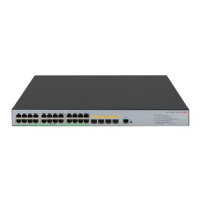80
interface in the corresponding routing entry is the RPF interface and the next hop is the RPF
neighbor. The router considers the path along which the packet from the RPF neighbor arrived
on the RPF interface to be the shortest path that leads back to the source.
{ The router automatically chooses an optimal static multicast route by searching its static
multicast routing table, and using the IP address of the packet source as the destination address.
The corresponding routing entry explicitly defines the RPF interface and the RPF neighbor.
2. The router selects one of these optimal routes as the RPF route. The selection process is as follows:
{ If configured to use the longest match principle, the router selects the longest match route from
the optimal routes. If these routes have the same mask, the router selects the route with the
highest priority. If the routes have the same priority, the router selects a route as the RPF route
according to the sequence of static multicast route, and unicast route.
{ If not configured to use the longest match principle, the router selects the route with the highest
priority. If the routes have the same priority, the router selects a route as the RPF route according
to the sequence of static multicast route, and unicast route.
The "packet source" means different things in different situations:
• For a packet traveling along the shortest path tree (SPT) from the multicast source to the receivers or
the rendezvous point (RP), the packet source for RPF check is the multicast source.
• For a packet traveling along the rendezvous point tree (RPT) from the RP to the receivers, or along
the source-side RPT from the multicast source to the RP, the packet source for RPF check is the RP.
• For a bootstrap message from the bootstrap router (BSR), the packet source for RPF check is the BSR.
For more information about the concepts of SPT, RPT, source-side RPT, RP, and BSR, see "Configuring PIM
(
available only on the S5500-EI)."
RPF check implementation in multicast
Implementing an RPF check on each received multicast data packet would be a big burden to the router.
The use of a multicast forwarding table is the solution to this issue. When creating a multicast routing
entry and a multicast forwarding entry for a multicast packet, the router sets the RPF interface of the
packet as the incoming interface of the (S, G) entry. After receiving an (S, G) multicast packet, the router
first searches its multicast forwarding table:
1. If the corresponding (S, G) entry does not exist in the multicast forwarding table, the packet
undergoes an RPF check. The router creates a multicast routing entry based on the relevant routing
information and adds the entry into the multicast forwarding table, with the RPF interface as the
incoming interface.
{ If the interface that received the packet is the RPF interface, the RPF check succeeds and the
router forwards the packet to all the outgoing interfaces.
{ If the interface that received the packet is not the RPF interface, the RPF check fails and the
router discards the packet.
2. If the corresponding (S, G) entry exists, and the interface that received the packet is the incoming
interface, the router forwards the packet to all the outgoing interfaces.

